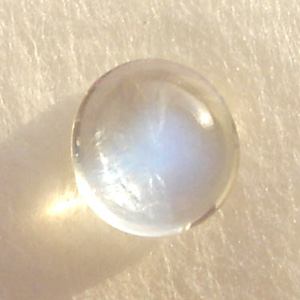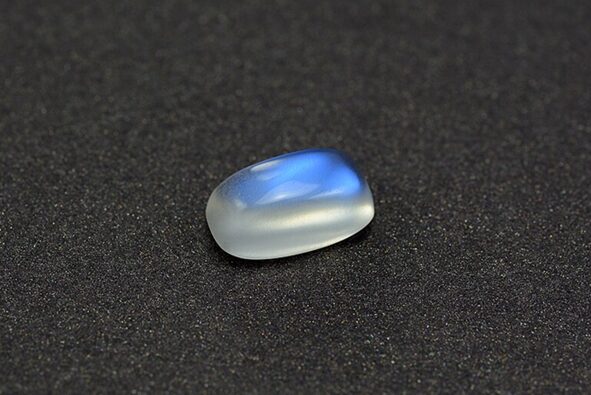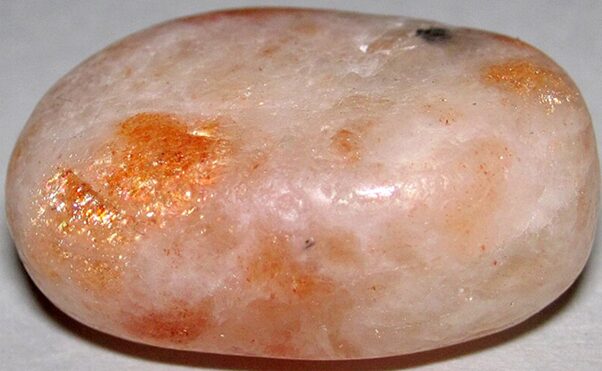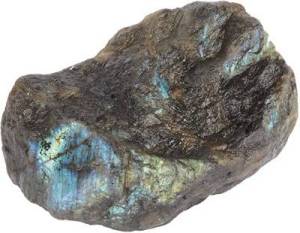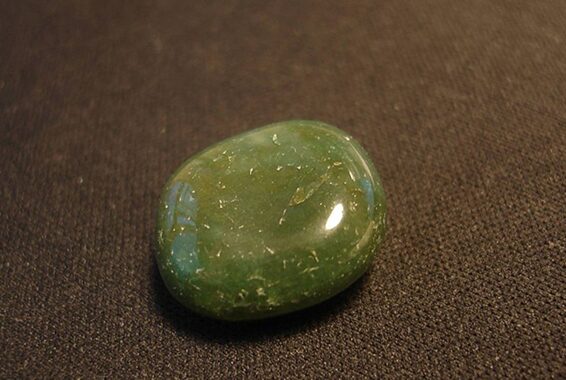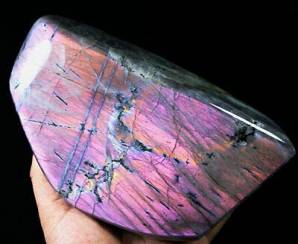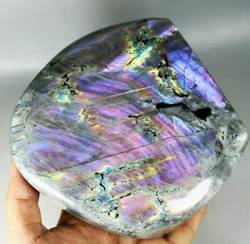Labradorescence mesmerizes with its shifting colors, while adularescence enchants with its soft, glowing sheen—both revealing the hidden magic within certain gemstones. These sub-types of the Schiller effect make certain stones glow with an ethereal, otherworldly light.
Adularescence in Moonstone
Image Source: https://commons.wikimedia.org/wiki/File:Moonston.jpg
Table Of Contents
- 1) Understanding the Schiller Effect in Stones
- 1.a) The Science Behind the Schiller Effect: Optical Phenomena in Gemstones
- 1.b) Examples of Gemstones Exhibiting the Schiller Effect
- 2) Distinguishing the Schiller Effect from Other Gemstone Phenomena
- 3) The Role of Color and Light in Gemstone Phenomena
- 4) The Importance of Stone Cut and Polish in Enhancing Optical Effects
- 5) How Color Variations Influence The Beauty And Rarity Of Adularescent And Schiller Effect Gemstones
- 6) Integrating Gemstones with Adularescence and Schiller Effect into Jewelry
- 7) Maintaining and Caring for Adularescent and Schiller Effect Gemstone Jewelry
|
|
1) Understanding the Schiller Effect in StonesBack To Top |
The Schiller effect is a shimmering light display seen in some gemstones. It results from light reflecting off tiny inclusions within the stone. These inclusions can be flat plate-like minerals or tiny cavities arranged in layers. The spellbinding Schiller effect adds a unique, seductive quality to the gems.
|
|
1.a) The Science Behind the Schiller Effect: Optical Phenomena in GemstonesBack To Top |
The refraction of light within the interiors of the gemstone synthesizes the schiller effect. Multiple layers of feldspar belonging to different genera populate the gem’s interior. What you have here is a misaligned mineral sundae. The Diverse feldspars bring a ragtag of refractive indices into the gemstone. Consequently, light rays bend at different angles while passing through these various mineral layers.
The Schiller effect can be further broken down into three sub-types viz.: Aventurescence, Adularescence and Labradorescence :
1) Adularescence:
Adularescence is the milky, bluish glow seen in moonstone. This effect is caused by light scattering within the thin layers of the feldspar mineral. The light reflects and refracts within these layers, creating a soft, floating light effect that moves as the stone is turned.
Natural Blue Moonstone Loose Gemstone |
Image source: wikimedia.org. Licensed under Creative Commons. |
2) Labradorescence:
Labradorescence, seen in labradorite, is a vibrant play of colors including blues, greens, and golds. This phenomenon is due to light diffracting within the microscopic structures of the mineral. The diffraction causes a striking display of colors that shift with the angle of light and observation.
3) Aventurescence:
Aventurescence, or the classic Schiller effect, is seen in stones like sunstone and aventurine. It occurs due to light reflecting off small mineral platelets within the gemstone. These reflections produce a sparkling or glittery effect, often with a metallic luster.
Potassium Feldspar Sunstone With Hematite Inclusions |
Image source: wikimedia.org Licensed under Creative Commons Attribution 2.0 Generic license. |
Sunstone is a type of feldspar known for its sparkling inclusions that produce warm to rainbow-colored flashes. These inclusions typically consist of tiny clusters of hematite plates (iron oxide). A unique variant, Oregon sunstone, contains inclusions of native copper. This particular example is potassium feldspar with hematite inclusions. |
|
|
1.b) Examples of Gemstones Exhibiting the Schiller EffectBack To Top |
Several gemstones display the Schiller effect, each with unique characteristics:
1) Labradorite:
Labradorite is known for its striking labradorescence. This feldspar mineral shows a range of colors including blue, green, and yellow. The effect is due to light diffraction within the stone’s structure. It’s popular in custom jewelry designs.
7190 Ct. Labradorite Rough Gemstone
Click On The Image
2) Moonstone:
Moonstone exhibits adularescence, a soft, milky glow that shifts as the stone moves. This effect is caused by light scattering between the layers of feldspar within the stone. Moonstone is a favorite for elegant jewelry pieces.
3) Sunstone:
Sunstone displays aventurescence, a glittering effect caused by light reflecting off copper or hematite inclusions. This feldspar mineral can range in color from clear to reddish-orange. Sunstone from Oregon is particularly noted for its vibrant appearance.
4) Aventurine:
Aventurine, often green, shows aventurescence due to mica or hematite inclusions. These inclusions give the stone a shimmering appearance. Aventurine is commonly used in decorative items and jewelry.
Gemstone Aventurine |
Image source: wikimedia.org. Licensed under Creative Commons. |
Aventurine is known for its shimmering effect called aventurescence caused by tiny mineral inclusions of mica or hematite. This gemstone is believed to bring luck and prosperity to its wearer. |
These gemstones are highly prized for their unique optical effects, making them stand out in any jewelry collection. By understanding these effects, one can appreciate the true beauty and value of these stones.
|
|
2) Distinguishing the Schiller Effect from Other Gemstone PhenomenaBack To Top |
There are several optical effects in gemstones, each unique in its way:
Attribute |
Asterism |
Chatoyancy |
Play-of-Color |
|---|---|---|---|
Definition |
Asterism appears as a star-shaped light reflection on the surface of certain gemstones, most commonly sapphires and rubies. | Chatoyancy, also called the cat’s eye effect, is a sharp, moving band of light resembling the slit of a cat’s eye. | Play-of-color is a shifting spectral display of colors, caused by light interacting with an opal’s internal silica structure. |
Cause |
This effect is caused by rutile needle inclusions within corundum, such as sapphires and rubies. Other minerals can display asterism due to different inclusions. | It occurs due to densely packed, parallel fibrous inclusions or hollow tube structures inside the gem, which reflect light in a concentrated band. | Play-of-color results from interference of light as it passes through the ordered silica spheres in opal. The size and arrangement of these spheres control the colors seen. |
Light Interaction |
A single direct light source causes light to reflect off inclusions, forming a well-defined star shape. | The sharpness of the cat’s eye effect depends on how well-aligned and dense the inclusions are. A sharply defined, bright line is most prized. | Light passing through an opal breaks into different colors due to diffraction, creating a vivid and ever-changing color display that shifts with movement. |
Best Cut for Effect |
A cabochon cut, with a smooth, rounded dome, enhances the star effect by allowing light to reflect properly. | A cabochon cut is essential for chatoyancy to appear clearly, as it focuses light into a single, moving band. | Opals can be cut in cabochon or freeform shapes to maximize play-of-color. Transparent opals may also be faceted. |
Common Gemstones |
Sapphire, ruby, garnet, diopside, spinel. | Chrysoberyl, tiger’s eye, tourmaline, quartz. | Opal with true play-of-color, andesine to a lesser extent. |
Rarity |
High-quality six-rayed asterism with a bright, centered star is extremely rare. | Chrysoberyl with a sharp, centered cat’s eye effect is highly rare, while tiger’s eye is more common. | Precious opals with intense, full-spectrum play-of-color are rare, though common opals are abundant. |
Best Viewing Condition |
A single strong light source, such as sunlight or a flashlight, highlights the star effect best. | A moving light source or rotating the stone under direct light enhances the effect. | Diffuse lighting or sunlight enhances the shifting spectral hues. |
Famous Examples |
Star of India sapphire, Rosser Reeves Star Ruby. | Tiger’s Eye gemstones, Cat’s Eye Chrysoberyl. | The Andamooka Opal, The Olympic Australis Opal. |
Each of these phenomena is distinct but shares the common trait of light interacting with internal structures within the gemstone. By understanding these differences, one can better appreciate the unique beauty each effect brings to gemstones.
|
|
2.a) What Is Adularescence In GemstonesBack To Top |
Adularescence is a soft, milky glow seen in gemstones like moonstone. This effect occurs when light scatters within the thin layers of the stone.
Defining Adularescence and How It Occurs.
Adularescence is an optical phenomenon found in gemstones, primarily moonstones. It creates a floating, billowy light effect that seems to move under the surface of the stone. This effect is caused by light interacting with layers of different minerals within the gemstone.
Moonstone, a type of feldspar, exhibits this effect due to its internal structure. The stone contains alternating layers of orthoclase and albite. When light enters the stone, it scatters between these layers, producing the characteristic glow. This glow, often blue or white, shifts as the stone or light source moves.
This effect is best seen in cabochon-cut stones, which have a smooth, rounded surface. The quality of adularescence can vary based on the thickness and regularity of the layers within the stone.
|
|
2.b) What is Labradorescence in Gemstones?Back To Top |
Labradorescence is a captivating optical phenomenon seen in certain gemstones, most notably labradorite. This effect creates a striking play of colors, often compared to the Northern Lights.
Physical Properties of Labradorite
Labradorite is a member of the feldspar group. It exhibits a range of colors, from gray to black, with flashes of blue, green, yellow, and occasionally red or purple. Its hardness ranges from 6 to 6.5 on the Mohs scale, making it moderately durable. Labradorite is typically translucent to opaque, and its luster is vitreous to pearly.
Cause of Labradorescence.
Labradorescence is caused by the interference of light within the gemstone’s internal structure. Labradorite contains thin layers of different minerals. When light enters the stone, it is refracted, reflected, and scattered by these layers, producing vivid flashes of color. The thickness and orientation of these layers affect the colors and intensity of the labradorescence.
Variations in Labradorescence.
The quality and intensity of labradorescence can vary widely. Some stones exhibit a full spectrum of colors, while others may show only a few hues. High-quality labradorite with a strong color display is often referred to as spectrolite, especially if it originates from Finland.
|
|
3) The Role of Color and Light in Gemstone PhenomenaBack To Top |
Color and light play crucial roles in creating optical effects in gemstones. How light interacts with a gem’s internal structure determines its unique visual phenomena. Variations in color result from light diffraction, scattering, and reflection within the stone.
|
|
3.a) How Light and Color Interact with Mineral Structures to Produce Stunning Schiller Effect, Adularescence, and LabradorescenceBack To Top |
Light and color interactions with minerals create captivating visual effects in gemstones like adularescence, labradorescence, and the Schiller effect.
Light’s Dance Through Layers of Orthoclase and Albite Generates Adularescence:
Adularescence occurs in moonstone due to the interaction of light with alternating layers of orthoclase and albite within the stone. Light enters the stone, scatters between these layers, and creates a soft, floating glow that shifts with the stone’s movement. This effect is most pronounced in cabochon-cut moonstones, particularly those with a blue adularescence.
Light’s Spectacular Diffraction in Labradorite Leads to Labradorescence:
Labradorescence is seen in labradorite and is caused by light diffraction within its microscopic structures. The internal layers of labradorite, which consist of different feldspar minerals, cause light to scatter and produce vibrant flashes of color, such as blue, green, and orange. This effect is enhanced by the stone’s dark base color, making labradorite a popular choice for visually striking jewelry.
Schiller Effect: Shimmering Magic of Light Reflecting Off Tiny Mineral Platelets:
The Schiller effect, also known as aventurescence, is a general term for the shimmering appearance seen in gemstones like sunstone and aventurine. It occurs when light reflects off tiny mineral platelets within the stone, creating a glittering effect. This optical phenomenon results from the interference and reflection of light within the layers of the gemstone, similar to the processes that cause adularescence and labradorescence.
|
|
4) The Importance of Stone Cut and Polish in Enhancing Optical EffectsBack To Top |
The cut and polish of a gemstone significantly influence its optical effects. A well-cut stone enhances light interaction, increasing brilliance and color display. Precision in cutting ensures optimal light reflection and refraction within the stone.
|
|
4.a) Precision Cutting Unlocks a Gemstone’s True BrillianceBack To Top |
A well-executed cut enhances the way light interacts with a gemstone’s internal structure, amplifying its optical effects. Skilled lapidaries shape each stone to maximize adularescence, labradorescence, or the Schiller effect. Even the slightest angle adjustment can mean the difference between a dull surface and a mesmerizing glow.
Cut Quality: Mastering Light’s Path Through the Gem.
The quality of the cut affects how light travels through the gem. A symmetrical and well-proportioned cut maximizes light return, enhancing the stone’s brilliance. For example, in moonstones, the cabochon cut best displays adularescence by allowing light to scatter within its layers.
Polishing Perfects the Stone’s Reflective Surface:
Polishing smooths the stone’s surface, reducing imperfections that can scatter light. A highly polished surface allows for better light entry and reflection, intensifying optical effects like the Schiller effect in sunstone and labradorite.
Cutting Styles Highlight Optical Wonders:
Different cutting styles can emphasize specific optical phenomena. For instance, faceted cuts enhance a gemstone’s sparkle, while cabochon cuts highlight phenomena like adularescence and labradorescence. The choice of cut depends on the desired visual effect and the stone’s inherent properties.
|
|
5) How Color Variations Influence The Beauty And Rarity Of Adularescent And Schiller Effect GemstonesBack To Top |
Color variations significantly impact the perceived quality and value of gemstones. The three dimensions of color—hue, saturation, and tone—determine a gem’s overall appearance. Uniformity of color is also crucial; gemstones with consistent color are more highly valued. Inconsistencies like color zoning can detract from a gem’s appeal.
|
|
5.a) The Impact of Color on a Gemstone’s Allure and ValueBack To Top |
Subtle shifts in color can make an adularescent or labradorescent gemstone appear more mystical and rare. Blue flashes in moonstones and vibrant spectral hues in labradorite are highly prized for their striking visual appeal. Collectors and designers seek out these unique variations, as no two stones display light in exactly the same way.
Adularescence and Color Variations:
Adularescence, the ethereal glow seen in moonstones, can vary in color from blue to white. The most prized moonstones exhibit a strong blue adularescence with a clear, colorless body. Variations in the body color or interruptions in the adularescent sheen can reduce the stone’s value. A consistent and intense blue adularescence that seems to float under the surface is highly sought after.
Labradorescence and Color Variations:
Labradorescence, primarily seen in labradorite, showcases a spectrum of colors like blue, green, and orange. The quality and intensity of these colors depend on the stone’s internal structure and the uniformity of the layers causing the effect. Stones with a broad range of vibrant colors and minimal color zoning are considered more valuable. Any disruptions or dull areas in the color play can significantly affect the gemstone’s perceived quality.
Schiller Effect and Color Variations:
The Schiller effect, or aventurescence, creates a shimmering appearance in gemstones like sunstone and aventurine. This effect results from light reflecting off tiny mineral platelets within the stone. The color and intensity of the Schiller effect can vary, with stones displaying a strong, uniform shimmer being the most valuable. Variations in the distribution of the reflective inclusions can lead to uneven shimmering, reducing the stone’s overall appeal.
4.21lb Polished Nice Rainbow Purple Flash Labradorite Spectrolite Reiki Stone
Click On The Image
|
|
6) Integrating Gemstones with Adularescence and Schiller Effect into JewelryBack To Top |
Gemstones with adularescence add a unique glow to any piece of jewelry. Their shifting colors create an enchanting effect. This makes them perfect for rings, pendants, and earrings.
|
|
6.a) Designing Jewelry With Adularescent And Labradorescent GemstonesBack To Top |
Selecting the Right Gemstones.
When creating jewelry, selecting gemstones with adularescence or the Schiller effect is crucial. Moonstone, labradorite, and sunstone are popular choices. These stones display unique optical effects, making each piece distinct and captivating.
Cutting and Setting Techniques.
Cutting and setting these stones require precision to highlight their optical phenomena. Cabochon cuts are preferred for moonstone and labradorite to enhance their glow. Proper orientation during cutting ensures maximum light reflection, showcasing their inner luminescence.
Design Considerations.
Designs should focus on simplicity to let the gemstone shine. Minimalist settings in rings, pendants, and earrings allow the stone’s natural beauty to stand out. Combining these gemstones with metals like silver or white gold can further enhance their mystical appearance.
These steps ensure that the jewelry pieces not only capture the eye but also the imagination, offering a touch of magic in every design.
4.67lb Polished Rainbow Purple Flash Labradorite Spectrolite Form Crystal
Click On The Image
|
|
7) Maintaining and Caring for Adularescent and Schiller Effect Gemstone JewelryBack To Top |
Adularescent and labradorescent gemstones need gentle care to keep their glow alive. Their delicate optical effects can fade or dull if exposed to rough handling, heat, or harsh chemicals. With proper storage and mindful cleaning, these luminous stones will continue to shimmer beautifully for years.
|
|
7.a) Preserving the Radiance of Adularescent and Labradorescent GemstonesBack To Top |
Proper care ensures these luminous gemstones retain their mesmerizing glow. Avoid harsh chemicals and ultrasonic cleaners, as they can damage the delicate internal structures that create their optical effects. Store them separately in a soft-lined box to prevent scratches and preserve their natural beauty.
Gentle Cleaning Methods.
To clean gemstones like moonstone and labradorite, use warm water and a mild detergent. Gently scrub with a soft brush to avoid scratching the surface. Avoid ultrasonic cleaners as they can damage these delicate stones.
Protecting from Light and Heat.
Store these gemstones away from direct sunlight and extreme temperatures to prevent fading and cracking. Heat and light can cause structural damage, reducing the beauty and integrity of the stones.
Regular Inspections.
Have your jewelry inspected by a professional jeweler every six months. This helps catch any potential issues early, such as loose settings or damaged prongs, ensuring the longevity of your pieces.
See More Phenomenal Gemstones As Follows
| Phenomenal Gemstones | Asterism in Star Gemstones |
| Chatoyancy | Gemstone Fluorescence |
